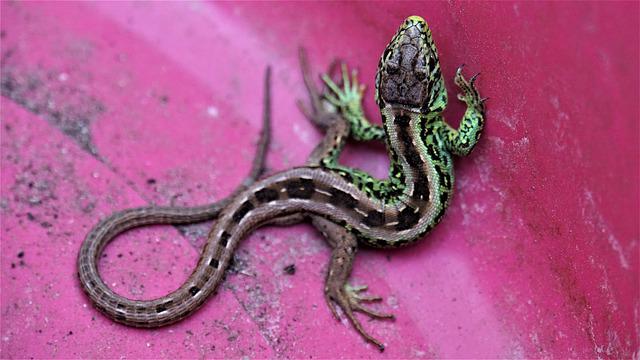When a question like ”How often do giant day geckos lay eggs?” comes to mind, it kicks up a lot of other questions with it. Questions involve caring for geckos, stimulating them to breed, and caring for their eggs and offspring.
In this article, we’re going to answer all of those questions. We’ll discuss everything from proper housing, feeding and diet habits, and breeding to incubating eggs and caring for hatchlings.
Frequency of Giant Day Geckos Laying Eggs
Giant day geckos lay eggs in two about six times clutches during the breeding season. The breeding season extends from December to June, during which the geckos lay eggs every 4-6 weeks.
Giant Day Gecko Housing
To raise giant day geckos, you’ll want to make them feel like they’re in their natural habitat. Doing so would make them feel at home and encourage them to eat and breed naturally.
The proper housing would be an aquarium with snake plants, sansevieria, bromeliads, and other tropical types. Giant day geckos would lay their eggs between the leaves of those plants.
An Aquarium As Warm As Home
To make the aquarium as suitable as possible for your geckos, you’d need to be aware of certain factors such as size, temperature, lighting, and humidity.
The recommended size would be 12×12 inches with 24 inches of height for smaller species. Larger species would need 18×18 inches with 36 inches of height.
You can also find commercially available aquariums ready with plants and soil for your geckos.
Maintaining the temperature in the aquarium at 79–90℉ at day and 65–72℉ at night is essential. You’ll also need proper lighting using full-spectrum light to replicate sunlight.
Humidity would be best if maintained between 50–85%. To increase humidity, you may want to mist the warm water.
Giant Day Gecko Diet
Giant day geckos typically feed on insects, other invertebrates, flower nectar, soft fruits, and pollen in the wild.
However, you may need to feed your geckos a diet mix in captivity. Compounds usually contain baby food and insects. It should also include vitamins and mineral supplements.
If you want to feed your geckos insects, offer them insects that don’t exceed the length between your geckos’ eyes.
Giant Day Gecko Breeding
Stimulating your geckos to breed is essential if you’re interested in their eggs or offspring. But first, you need to identify the males from the females to know which to put with which for mating.
The males are easily identified by the pores that appear on the back of their legs. Those pores are less-developed in females and usually are absent.
Getting Your Geckos to Mate
To get your geckos together, it’s better to introduce them to their environment first. Make sure that the time between submitting the two is not prolonged, as that would make the first one aggressive towards introducing the second.
It’s better to introduce one male with one female, as introducing another female may increase the chances of aggression.
Good Signs and Bad Signs
You should keep a close look as sometimes, instead of getting together, geckos may become violent with each other. Separate the pair immediately if ominous signs appear and replace the male gecko with another one.
Good signs would be head wagging, licking, and the male showing his back to the female. She would let him grab her neck as she accepted him while they mate.
Ominous signs would be bite marks and pieces of ripped skin on one or both geckos. You can also find them chasing, or one of them may be hiding.
Giant Day Gecko Eggs Incubation
The two eggs that the geckos lay are often attached. They’re not glued to the surface they’re laid on, so you can easily remove them for incubation.
Place the eggs carefully on a substrate base of vermiculite inside the incubator. Adjust the temperature to about 81℉ and humidity level to 60%.
The eggs will typically hatch in the period from 55–65 days.
Growing Them Naturally
Some gecko keepers prefer to incubate eggs naturally outside incubators. They choose humid ventilated containers at average room temperature.
Allowing them to experience the change in temperature between day and night produces healthier offspring with a better male-to-female ratio.
Giant Day Gecko Hatchlings Care
The young hatchlings you get after the eggs require more special care than the adult ones. It would help if you separated them from adults and each other so that they don’t have to compete with each other for food and be aggressive in the process.
You should provide them with the same temperature and humidity that you keep the adults in. However, the feeding process will differ entirely.
In the first few months, you have to feed them daily; nectar one day and parts of insects the next. And as they mature, the portions decrease to twice per week for insects and once per week for nectar.
Conclusion
How often do giant day geckos lay eggs? The answer is every 4-6 weeks in the breeding season. However, to achieve this, you must keep them healthy for breeding by feeding them properly.
Providing suitable housing containing plants they could lay their eggs upon can significantly increase their chances of breeding. You should also pay extra attention to the housing’s lighting, temperature, and humidity.
Breeding geckos need a careful eye for anything that can go wrong. And taking special care of the eggs until they hatch and the hatchlings in the first months is essential for maintaining the breeding cycle.




